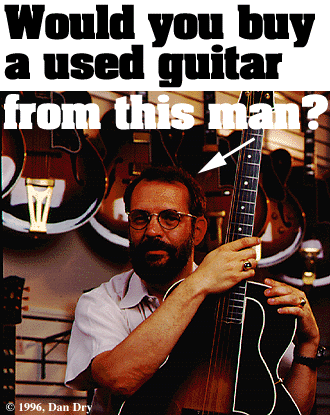
The University of Chicago Magazine
August 1996

Continued
some 25 people in his latest store, a completely renovated warehouse that features hundreds of new and used instruments--gleaming beauties from Fender, Gibson, and Martin--on the first floor; dozens of high-end collectibles, like a 1959 Les Paul (the Holy Grail of rock guitars) for sale for a cool $45,000, on the second floor; storage and packing facilities on the third; and an extensive repair shop on the fourth.
Not bad for a guy who started buying and selling instruments during his first year in the College, the same year he was almost thrown out of Burton-Judson Courts for overpopulating his room with snakes and spiders.
This latter fascination began at age 4, when Gruhn amassed his first collection: a scaly mix of frogs, salamanders, insects, and turtles. A few years later, he developed a passion for snakes, creating the first of many "mini-menageries" in his parents' basement. "If it was 'educational,' my parents would encourage it, and I could get away with anything," he recalls.
Gruhn had always thought he would be an academic, studying biology or zoology and then following in the footsteps of his father, now a professor emeritus of pathology at the Northwestern University Medical School. When his family moved to the Chicago area, and Gruhn became a freshman at Oak Park-River Forest High School, he was "as fanatically into snakes then as I am now into guitars," he says. "I had a zoo."
In fact, he sees a connection between reptiles and vintage instruments: "I've always been aware that you can look at these things like specimens. It is not a big step to go from counting scale rows of snakes to counting the internal braces on an acoustic guitar. You look at them in the same manner. Reptiles are much more akin to the musical instruments than say, amphibians, which never did much for me--they just have smooth, slimy, unfeatured skin." For both guitars and reptiles, in Gruhn's eyes, "everything important is right there to be seen."
He calls high school--where one of his friends was the late Bruce Kaplan, AB'66, AM'68, founder of the seminal folk and blues record company, Flying Fish--"probably the most fun I ever had in my educational experience." Gruhn came to the University with the hope of finding a similar community. He did, but it wasn't in the sciences.
"The old style in biology of observational nature studies--I like to call it 'watching beasties'--had been replaced by a more mathematical approach to molecular biology. Since I had moved so often, I really didn't have a good foundation in math," he confesses. "To this day, I don't know my multiplication tables."
Instead, he found a home in the psychology department. "I had taken a psychology course with Erich Klinghammer," Gruhn says. Klinghammer, AB'58, PhD'62, "was part of a German school of thinking that focused on animal behavior and that was in control of the department. Here was my hook--it was old-style nature studies, it was beastie watching!
"Besides," Gruhn laughs, "Klinghammer was fanatical about what he did, and me being a fanatic, I fit right in."
At the same time that Gruhn was shifting his studies to psychology, he was also discovering the music scene surrounding the U of C Folklore Society's Folk Festival.
Although he'd started listening to folk music in high school, Gruhn didn't buy his first guitar until he got to the University, when he picked up a Conde Hermanos classical guitar for $300. It was, he says, "a fine guitar and would cost $3,000 now," but it wasn't the right guitar--or at least one that country-music legend Maybelle Carter, "my hero at the time," would play.
"If you wanted to play folk or country, a Martin guitar was the 'correct' one to own," Gruhn explains. "All the great players had
Continue reading "Would you buy a used guitar from this man?"
Go to:
- INVESTIGATIONS
- CHICAGO JOURNAL
- EVENTS
- LETTERS
- CHICAGOPHILE
- Feature story, a profile of George Gruhn, AB'67, "Would you buy a used guitar from this man?"
- Feature story, drawings from Reunion 1996 in June, "Scenes from a Reunion"
- Feature story, a profile of Abner Mikva, JD'51, "Dissenting Opinion"
- CLASS NEWS
- DEATHS
- BOOKS
- IN THE CLUBS
- ALUMNI AWARD-WINNERS
